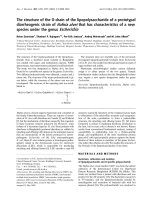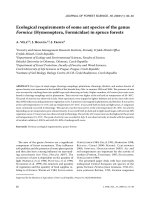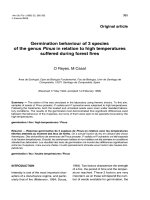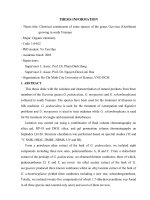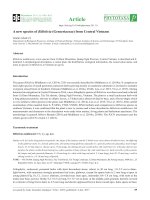Two new species of the genus Halaphanolaimus de Man, 1876 (Nematoda: Leptolaimidae) from Cangio mangrove forest, Vietnam
Bạn đang xem bản rút gọn của tài liệu. Xem và tải ngay bản đầy đủ của tài liệu tại đây (855.13 KB, 8 trang )
29(3): 7-14
T¹p chÝ Sinh häc
9-2007
Two new species of the genus
Halaphanolaimus de Man, 1876 (Nematoda: Leptolaimidae)
from Cangio mangrove forest, Vietnam
Vladimir g. gagarin
Institute of Inland waters Biology of Russian Academy of Science, Russia
Nguyen Vu Thanh
Institute of Ecology and biological Resources, Vietnam
Summary
New brackish water nematode species Halaphanolaimus cangionensis sp.nov, and Halaphanolaimus
rivalis sp.nov collected from Cangio mangrove forest, Hochiminh city of Vietnam are described.
Halaphanolaimus cangionensis sp.nov is characterized by the absence of somatic and cervical setae,
comparatively slender tail, presence of caudal apophysis of the gubernaculum and comparatively short
spicules. New species Halaphanolaimus cangionensis sp.nov resembles to Halaphanolaimus harpaga Boucher,
Bovee, 1972 and Halaphanolaimus luridus (Timm, 1963) but differs from H. harpaga by the absence of
somatic and cervical setae, more anterior position of vulva, another structure of gubernaculums and other
arrangement of precloacal supplements. The new species differs from H. luridus by the more slender tail, longer
stoma, another structure of gubernaculums and shorter spicules. Halaphanolaimus rivalis sp.nov is characterized
by the presence of somatic and servical setae, long spicules and pre-equatorial vulva. New
species Halaphanolaimus rivalis sp.nov, resembles to Halaphanolaimus luridus (Timm, 1963) and L. lorenzeni
Boucher, Bovee, 1972 but H. rivalis sp.n. differs from H. luridus by the presence of somatic and cervical
setae, more wide labial region, longer stoma, shorter spicules. H. rivalis sp.n. differs from H. lorenzeni by the
thicker body, longer stoma and longer spicules. Key to six valid species of the genus Halaphanolaimus are given.
Key words: Nematoda, Halaphanolaimus, new species, Cangio mangrove, Vietnam.
Fauna of free-living brackish water and
marine nematodes of Vietnam is studied recently.
At present, this investigating field on nematode
biodiversity is strongly improved, in connection
with creating of the new database for the
biomonitoring assessment of water quality in
watershed and wetland ecosystems of whole
Vietnam. This work is a part of the Vietnam
National Project for study of biodiversity and
free-living nematode fauna of the Cangio
mangrove forest, belongs to the Hochiminh city
of Vietnam during 2000-2005 years. Cangio
mangrove forest located in the South of
Hochiminh city, Vietnam with latitude:
10°22´14´´-10°40´09´´
and
longitude:
106°46´12´´-107°00´59´´. The nematode samples
were collected at the March and April 20022004, In this paper, two new species of the
Leptolaimidae, Halaphanolaimus cangionensis
sp.nov, Halaphanolaimus rivalis sp.nov are
described.
I. MATERIAL AND METHODS
Samples are done from a boat using a Ponar
grab. In each station one grab is collected with
three replicated for nematodes analysis, all
samples are fixed in hot formalin 10%. The
nematodes are extracted by LUDOX - TM 50
solution with centrifugation method and
gradually transferred to anhydrous glycerin and
finally mounted into permanent slides.
This paper partly was supported by The National Science Council of Vietnam
7
Abbreviation used in the text:
L. total body length (µm); a. body length
divided by maximum body width; b. body
length divided by pharyngeal length; c. body
length divided by tail length; c’. tail length
measured in cloacal body diameters; V. relation
of distance from anterior body end to vulva for
body length at per cent.
II. DESCRIPTION
1. Halaphanolaimus cangionenisis sp.nov (fig.1)
Fig.1. Halaphanolaimus cangionenisis sp.nov
A. Entire male; B. Entire female; C. Head region; D. Cardial region of male;
E. Vulva region; F. Posterior end of male; G. Posterior end of female.
8
Measurements: Table 1.
Female: small, slender worms. Cuticle
coarse annulated; annules 1.2-1.5 µm wide.
Thickness of cuticle in vulva region about 1.0
µm. Lateral fields 1.3-1.5 wide, extend from
middle of oesophagus length to one a third of
tail length. Somatic setae absent. Labial region
isolated from the rest of body. Labial papillae
not visible. Four cephalic setae 1.5-2.0 µm long,
disposed in the base of labial region. Amphidial
fovea in form of the circle turn below, 1.8-2.0
µm in diameter, its anterior margin situated 7,08,0 µm from anterior body end. Stoma narrow
and long tube-shaped, 14-18 µm long (3.5-4.5
labial region width). Oesophagus slender,
muscular, basal bulb well developed, its length
approximately equal to corresponding body
width. Ventral gland, its canal and excretory
pore not observed. Cardia muscular, 6.5-8.5 µm
long. One tubular supplement 8.0-8.5 µm long,
situated ventrally at level of intestine beginning.
This tubular supplement absent at two females.
Rectum length shorter than anal body width.
One tubular supplement situated ventrally at
distance 20-21 µm (1.8-1.9 anal body width)
from anus. Reproductive system didelphic,
amphidelphic; ovaries antidromous. Vulva
as a rule praequatorial. Vagina situated
perpendicularly to longitudinal axis of the body;
its length approximately equal to one a third of
corresponding width. One or two eggs in uterus,
36-39 × 15-17 µm. Tail slender, gradually
narrowing. Papillae and setae at tail absent.
Terminus of tail smooth, not annulated and
slightly swollen. Caudal glands and spinneret
well developed.
Table 1
Measurements of Halaphanolaimus cangionensis sp.nov (all measurements in µm, exept ratio)
Characteristics
L
a
b
c
c’
V%
Oesophagus length
Posterior end of oesophagus to
vulva
Vulva to anus
Posterior end of oesophagus to
cloaca
Tail length
Labial region width
Stoma length
Cephalic setae length
Amphid fovea to body head
Spicules length (along arch)
Holotype
♂
537
32
5.1
6.6
5.8
106
Paratypes
11 ♂♂
range
mean
502-571
532
28-37
32
4.7-5.5
5.2
6.6-7.6
7.0
5.0-6.3
5.5
101-106
103
13 ♀♀
range
mean
499-570
535
24-30
27
4.9-5.5
5.2
5.7-7.1
6.3
6.8-8.1
7.4
47.2-50.4
48.3
90-107
103
-
-
-
136-182
155
-
-
-
175-203
192
350
322-388
353
-
-
81
4.0
18
2.0
8.0
17
70-84
3.5-4.0
15-18
1.5-2.0
7.0-8.0
16-18
76
4.0
17
1.75
7.5
17
76-91
3.5-4.5
14-18
1.5-2.0
7.0-8.0
-
85
4.0
16
1.8
7.5
-
Male: cuticle coarse annulated. Lateral
fields extend from middle of oesophagus to one
a third of tail length. Somatic setae absent.
Labial region isolated from the rest of body.
Labial papillae not visible. Cephalic setae 1.52.0 µm long, situated in the base of labial
region. Amphidial fovea in form of the circle,
torn below, about 2.0 µm in diameter, its
9
anterior margin situated 7.0-8.0 µm from
anterior body end. Stoma in form narrow tube,
15-18 µm long. Oesophagus slender, muscular
with well developed basal bulb. Cardia
muscular, 7.0-9.0 µm long. One tubular
supplement situated at level of the intestine
beginning. This tubular supplement absent at
one male. Testes paired, opposed. Spicules
paired, strongly curved, with well developed
capituli. Gubernaculum with one dorsal
apophysis and two narrow ventral apophyses.
Precloacal ventromedian supplements in form
cuticularized tubes, 11-13 µm long, 4 in number
always. Supplements situated at different
distance one after another. The longest distance
being between fourth and third supplements.
Distance between supplements (at brackets
being the mean quantities). Cloaca to fourth, 1822(20) µm; fourth to third 11-17(15) µm; third
to second, 19-23(20) µm; second to first, 4376(55) µm. Common length of supplemental
row being 93-126 µm. Papillae or setae at
precloacal region between supplements absent.
Tail slender, gradually narrowing. Caudal setae
absent. Tail-tip slightly swollen and smooth, not
annulated. Caudal glands and spinneret well
developed.
Type locality and habitat: Thi Vai river,
mangrove forest Cangio, Hochiminh city,
Vietnam. Depth of watrs 1.5-4.5 m, fine silt,
salinity 16-25‰.
Type material: holotype male on slide
number 48/II and paratypes 3 ♂♂ and 4 ♀♀ on
slide 48b/II deposited at the nematode collection
of the Institute of Inland Waters Biology, Borok,
Russia. Paratypes 7 ♂♂ and 8 ♀♀ on slide
48c/II deposited at the nematode collection of
the Institute of Ecology and biological
Resources, Vietnamese Academy of Science
and Technology, Hanoi, Vietnam
Differential diagnosis: the new species
resembles to Halaphanolaimus harpaga
Boucher, Bovee, 1972 and Halaphanolaimus
luridus (Timm, 1963) but differs from
H. harpaga by the absence of somatic and
cervical setae, more anterior position of vulva
(in H. harpaga, V = 51-53% in new species V =
47.2-50.4%), another structure of gubernaculums
and other arrangement of precloacal supplements
(Boucher, Bovee, 1972). The new species differs
10
from H. luridus by the more slender tail (in H.
luridus, c’ = 4.0-4.5 vs c’ = 5,0-8,1 in the new
species), longer stoma (in H. luridus, stoma 8 µm
vs 14-18 µm in new species), another structure of
gubernaculums and shorter spicules (in
H. luridus, spicules 35 µm vs 16-18 µm in new
species) (Timm, 1963).
Etymology: the species is refered to its type
locality: Cangio mangrove forest of Vietnam.
2. Halaphanolaimus rivalis sp.nov (Fig.2)
Measurements: Table 2.
Female: Small, slender worms. Cuticle
coarse annulated, annules 1.5 µm wide.
Thickness of cuticle 1.0-1.5 µm, lateral fields
about 1.5 µm wide, extend from middle of
oesophagus length to one a third of tail length.
Somatic setae situated at cervical region and at
the tail. Labial region isolated from the rest of
body. Labial papillae not visible. Four cephalic
setae about 3.0-3.5 µm long (50% of labial
region width) disposed in the base of labial
region. Amphidial fovea in form of the torn
below circle, 3.0 µm in diameter, its anterior
margin situated 6.5-7.5 µm from anterior body
end. Cervical setae short, 2 µm long. Stoma in
form of the narrow and long tube, 21-22 µm
long (3.3-3.5 lip region width). Oesophagus
slender, muscular, its basal bulb well developed,
pear-shaped, its length approximately equal to
corresponding body width. Ventral glands cell,
its canal and excretory pore not observed.
Cardia muscular, 7-9 µm long. One tubular
supplement, 11 µm long, situated ventrally at
level of intestine beginning. Rectum length
slightly shorter than anal body diameter. Anal
opening hardly observed. One tubular
supplement situated ventrally, at distance 31-35
µm from anus (3.0-3.5 anal body width).
Reproductive system didelphic, amphidelphic,
with
an
ovaries
antidromous.
Vulva
pre-equatorial. Vagina situated perpendicularly
to longitudinal axis of the body, its length
approximately an equal to one a third of
corresponding body width. Tail slender,
gradually narrowing. Tail tip smooth, not
annulated and slightly swollen, with 3-4 short
setae 2 µm long situated at the tail. Caudal
glands and spinneret well developed.
Fig. 2. Halaphanolaimus rivalis sp.nov
A. Entire male; B. Entire female; C. Head region; D. Oesophagus bulb;
E. Vulva region; F. Spicule structure with precloacal supplements; G. Tail of female.
Male: similar to females in general
morphology. Cuticle coarse annulated. Lateral
fields extend from middle of oesophagus to one
a third of tail length. Labial region isolated from
the rest of body. Labial papillae not visible.
Cephalic setae 3.0-3.5 µm long. Cervical setae 2
µm long. Amphidial fovea in form of the circle,
torn below, 3.0 µm in diameter, its anterior
margin situated 7.0-8.0 µm from anterior body
end. Stoma in form narrow tube, 19-21 µm long.
Oesophagus slender, muscular, its basal bulb
well developed. Cardia muscular, 7-9 µm long.
11
One tubular supplement, 12-13 µm long,
situated at intestine beginning. One setae, 3 µm
long, disposed in front of the cloaca. Testes
paired, opposed. Spicules paired, strongly
curved, with well developed capituli.
Gubernaculum with one caudal apophysis.
Precloacal ventromedian supplements in form
cuticularized tubes, 14-18 µm long 4 in number
always. Supplements situated at different
distance one after another. The longest distance
being between first (the distantest from cloaca)
and second supplement; the smallest distance
being between second and third supplements.
Distance between supplements (at brackets
being the mean quantities): cloaca to fourth, 2528(27) µm; fourth to third, 22-30(25) µm; third
to second, 13-17(14) µm; second to first, 7694(86) µm. Common length of supplement row
being 149-158 µm. Papillae and setae at
precloacal region between supplements absent.
Tail slender, gradually narrowing. Tail armed 35 short setae, 2 µm long. Tail tip smooth, not
annulated and slightly swollen. Caudal glands
and spinneret well developed.
Table 2
Measurements of Halaphanolaimus rivalis sp.n. (all measurements in µm, except ratio)
Characteristics
L
a
b
c
c’
V%
Oesophagus length
Posterior end of oesophagus to
vulva
Vulva to anus
Posterior end of oesophagus to
cloaca
Tail length
Labial region width
Stoma length
Cephalic setae length
Amphid fovea to body head
Spicules length (along arch)
Holotype
♂
3 ♀♀
724
30
5.3
9.9
4.0
136
-
range
686-754
30-37
5.3-5.8
7.8-9.9
4.0-5.8
122-137
-
mean
717
33
5.5
8.8
4.5
130
-
range
696-748
30-36
5.3-6.1
7.8-9.0
5.5-7.8
45.7-49.3
122-132
207-224
mean
719
33
5.7
8.2
6.8
47.9
127
217
515
476-529
505
263-308
-
284
-
73
6.0
21
3.0
7.5
28
70-92
5.5-6.0
19-21
3.0-3.5
7.0-8.0
27-28
82
6.0
20
3.0
7.5
27.5
7-98
5.5-6.0
20-21
3.0-3.5
6.5-7.5
-
91
6.0
20.5
3.0
7.0
-
Type locality and habitat: Thi Vai river,
mangrove forest Cangio, Hochiminh city,
Vietnam. Depth of waters 1,5-4,5 m, fine silt,
salinity 16-25‰.
Type material: holotype male on slide
number 50/II and paratypes 1 ♂ and 2 ♀♀ on
slide 50b/II deposited at the nematode collection
of the Institute of Inland Waters Biology, Borok,
Russia. Paratypes 5 ♂♂ and 1 ♀♀ on slide
50c/II deposited at the Nematode collection of
the Institute of Ecology and Biological
12
Paratypes
7 ♂♂
Resources, Vietnamese Academy of Science
and Technology, Hanoi, Vietnam
Differential diagnosis: the new species
resembles to Halaphanolaimus luridus (Timm,
1963) and L. lorenzeni Boucher, Bovee, 1972,
H. rivalis sp.n.differs from H. luridus by the
presence of somatic and cervical setae, more
wide labial region ( in H. luridus, labial region
4.0-4.5 µm wide vs 5.5-6.0 µm wide in new
species ), longer stoma ( in H. luridus, stoma 8
µm long vs 19 = 21 µm long in new species),
shorter spicules (in H. luridus, spicules 27-28
µv vs 35 µm long in new species) (Boucher,
Bovee, 1972). H. rivalis sp.nov differs from H.
lorenzeni by the thicker body ( in H. lorenzeni,
a = 40-45 vs a = 30-37 µm in new species),
longer stoma (in H. lorenzeni, stoma 16=17 µm
long vs 16-17 µm in new species) and longer
spicules ( in H. lorenzeni, spicules 16 µm long
vs 27-28 µm in new species) Lorenzen, 1972.
Etymology: the species name means “creek
bank” of the local mangrove forest.
Table 3
Morphometric characters of the valid species of the genus Halaphanolaimus
L. µm
a
b
c
C’
V. %
Somatic and cer.
setae
Lab region width, µm
Stoma length, µm
Cephalic setae, µm
Amphid fovea to
body head, µm
Spicules length, µm
Male pre. supplement
pellucidus
1460-1550
33-41
6.0-6.6
10.7-12.7
3.3-4.6
47.9
harpagi
430-518
26-35
3.8-4.5
6.9-8.3
4.2-5.6
51-53
lorenzeni
635-735
40-45
5.3-6.1
7.4-9.1
4.5-6.5
48
luridus
520-760
27-37
4.7-5.8
6.8-8.7
4.0-4.5
-
cangionensis
499-571
24-37
4.7-5.5
5.7-7.6
5.0-8.1
47.2-50.4
rivalis
696-754
30-37
5.3-6.1
7.8-9.9
4.0-7.8
45.7-49.3
+
+
+
-
-
+
8.0
23-25
3.0-4.0
4.0-5.0
?
2.0-3.0
5.0-5.5
16-17
2.0-2.5
4.0-4.5
8
3.0
3.5-4.5
14-18
1.5-2.0
5.5-6.0
19-21
3.0-3.5
10
8-9
8-9
7.0-7.5
7.0-8.0
6.6-8.0
47-52
6-7
15-16
4-5
16
4
35
4
16-18
4
27-28
4
Key to the valid species of the genus Halaphanolaimus
1. Body length between 1.4 mm and more………………………………………………H. pellucidus
- Body length 0.4 - 0.8 mm…..…...…………………………………………….…………………2
2. Cervical and somatic setae absent…………...………………………………………….…………3
- Cephalic and somatic setae present……………………………………………………………...4
3. Stoma 8 µm long; spicules 35 µm; c’ = 4.0-4.5.…………………………….…...………H. luridus
- Stoma 14-18 µm long; spicules 16-18 µm long; c’= 5.0-8.1.………….........H. cangionensis n.sp
4. Body 0.43-0.52 mm long; b = 3.8-4.5; V = 51-53%.....…………..…………...…..…….H. harpaga
- Body length 0.6 mm and more; b = 4,7 and more; V = 47% and less…..………….……………5
5. Stoma 16-17 µm long; a = 40-45; spicules 16 µm long..……………………….….….H. lorenzeni
- Stoma 19-21 µm long; a = 30-37; spicules 27-28 µm long…………….……….....H. rivalis n.sp
III. DISCUSSION
Nine species of the genus Halaphanolaimus
Southern, 1914 were described: H. pellucidus
Southern, 1914; H. longisetosus Allgen, 1928; H.
minutus Stekhoven, 1942; H. norvegicus Allgen,
1945; H. luridus (Timm, 1963); H. harpaga
Boucher, Bovee, 1972; H. lorenzeni Boucher,
Bovee, 1972; H. cangionensis sp.nov and
H. rivalis sp.nov Afterwards H. longisetosus
Allgen, 1928 and H. norvegicus Allgen, 1946
were transferred to the genus Alaimella Cobb,
1920 (Gerlach et Riemann, 1973). H. minutus
Stekhoven, 1942 described for one female only
and do not having tubular supplement at
oesophagus region, and be transferred to species
inquirenda. Boucher, Bovee, 1972 described new
species H. harpaga and transferred two species
13
from the genus Leptolaimus to the genus
Halaphanolaimus: H. luridus and H. lorenzeni.
Thus, six valid species of the genus
Halaphanolaimus are known at present (table 3).
Acnowledgement: this study was partly
supported by the Project Impact of mangrove
exploitation of the Benthic ecosystem and the
assessment of ecological quality objectives
(IMABE) of Belgium. The authors thank the
financial assistance from VLIR IMABE Project
during the period of study.
REFERENCES
1. Boucher G., Bovee F., 1972: Vie Milieu,
23(1): 127-132.
2. Gerlach A. S., Riemann F., 1973: Suppl.,
4: 1- 404.
3. Lorenzen S., 1972: Kieler Meeresforschungen, 28 (1): 92-93.
4. Tim R. W., 1963: Proceedings of the nematological society, Washington, 30(1): 34- 49.
Hai loài tuyến trùng mới thuộc giống Halaphanolaimus
de Man, 1876 (Nematoda: Leptolaimidae)
ở rừng ngập mặn Cần Giờ, Việt Nam
Vladimir G. Gagarin, Nguyễn Vũ Thanh
TóM TắT
Khu hệ Tuyến trùng nớc lợ, Tuyến trùng biển và Tuyến trùng ở hệ sinh thái rừng ngập mặn Việt Nam chỉ
mới đợc nghiên cứu trong mấy năm gần đây. Cho đến nay, trên toàn thế giới, 9 loài thuộc giống
Haliphanolaimus Southern, 1914 đã đợc mô tả là các loài H. pellucidus Southern, 1914;
H. longisetosus Allgen, 1928; H. minutus Stekhoven, 1942; H. norvegicus Allgen, 1945; H. luridus (Timm,
1963); H. harpaga Boucher, Bovee, 1972; H. lorenzeni Boucher, Bovee, 1972; H. cangionensis sp.nov;
H. rivalis sp.nov Tuy nhiên hai loài H. longisetosus Allgen, 1928 và H. norvegicus Allgen, 1946 đã đợc
Gerlach et Riemann, 1973 chuyển sang giống Alaimella Cobb, 1920, Loài H. minutus Stekhoven, 1942 đợc
mô tả chỉ dựa vào 1 con cái và không có nhú sinh dục phụ hình ống tại vùng gần cổ, do vậy đợc chuyển sang
loài cha đủ cơ sở dữ liệu để mô tả (species inquirenda). Boucher, Bovee, 1972 mô tả loài tuyến trùng mới
H. harpaga và tu chỉnh giống này với việc chuyển từ giống Leptolaimus sang giống Halaphanolaimus hai loài
H.luridus và H. lorenzen. Nh vậy cộng cả hai loài vừa mô tả tại Việt Nam, trong giống này hiện đã biết 6
loài.
Loài tuyến trùng mới Halaphanolaimus cangionensis sp.nov tơng đối giống loài Halaphanolaimus
harpaga Boucher, Bovee, 1972 và loài Halaphanolaimus luridus (Timm, 1963), tuy nhiên loài mới khác biệt
so với loài H. harpaga bởi chúng không có các lông somatic và các lông cổ; vị trí lỗ sinh dục cũng nằm về nửa
trớc nhiều hơn (ở loài H. harpaga, V = 51-53% so với V = 47,2-50,4% ở loài mới). Ngoài ra, loài mới cũng
có cấu tạo miếng đệm của gai sinh dục rất đặc trng và cách sắp xếp của các nhú phụ sinh dục (Boucher,
Bovee, 1972). Loài mới cũng khác biệt loài H. luridus bởi có cấu trúc đuôi dài hơn (ở H. luridus, c = 4,0-4,5
so với c = 5,0-8,1 ở loài mới), xoang miệng dài hơn (ở H. luridus, xoang miệng dài 8 àm so với 14-18 àm
của loài mới) và có gai sinh dục ngắn hơn (ở H. luridus, gai sinh dục dài 35 àm so với 16-18 àm ở loài mới).
Loài Tuyến trùng mới Halaphanolaimus rivalis sp.n. tơng đối giống loài Halaphanolaimus luridus
(Timm, 1963) và loài L. lorenzeni Boucher, Bovee, 1972, tuy nhiên khác loài H. luridus ở chỗ loài mới có
nhiều lông somatic, lông cổ, vùng môi rộng hơn (ở H. luridus, vùng môi rộng 4,0-4,5 àm so với 5,5-6,0 àm ở
loài mới), loài mới có xoang miệng dài hơn (ở H. luridus, xoang miệng dài 8 àm so với 19-21 àm ở loài mới)
và chiều dài gai sinh dục dài hơn (ở H. luridus, gai sinh dục dài 27-28 àm so với 35 àm ở loài mới).
Loài tuyến trùng mới Halaphanolaimus rivalis sp.n. khác biệt so với loài H. lorenzeni bởi cơ thể dầy, mập
hơn (ở H. lorenzeni, a = 40-45 so với a = 30-37 àm ở loài mới), gai sinh dục dài hơn ( ở loài H. lorenzeni, gai
sinh dục dài 16 àm so với 27-28 àm ở loài mới).
Ngày nhận bài: 11-5-2007
14

